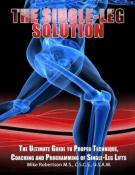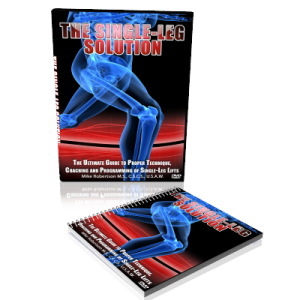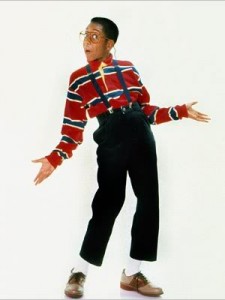I hope you enjoyed a relaxing 4th of July weekend…and/or recovered fully from your celebrating. Emily and I took off at the end of last week for Denver to go spend the weekend with her brother. I love it out there. If the Avalanche ever gave me a call I’d make the move out there in a heartbeat!
A couple weeks ago, I picked up a copy of Mike Robertson’s new DVD and manual set: The Single-Leg Solution
As you know, I’m a huge supporter of single-leg exercises for building lower body strength. I think hockey training programs should be based around single-leg lifts. In fact, I think training programs for all athletes should be based around single-leg lifts. With my hockey players, I followed what I think of as an inverted exercise model, whereby the traditionally thought of main lifts (which are all double leg squat and deadlift variations) are performed secondarily, if at all, following the traditionally thought of accessory lifts (single-leg lifts).
With that said, it’s easy to see why I’d be interested in the first ever product created to detail everything about the benefits (or lack thereof) of single-leg training, how to perform the lifts, and where they should fit in your program.
Single-Leg Solution Pros
The first thing I noticed about the product was that the cover is absolutely sick. I don’t know how Mike has doing his graphics, but I’m jealous.
After reading through the 96-page manual and watching the hour long DVD, I was really impressed with the comprehensive descriptions of the exercises. As I watched, I was thinking about how much I’d like every athlete I work with to have access to the DVD so they came to me knowing EXACTLY how I wanted them to perform the lift. For that matter, I wish every intern/job applicant also came equipped with that knowledge.
Mike’s DVD brilliant breaks down exactly how to perform the single-leg lifts (and their variations), common undesired movements, and how to coach athletes out of undesired movement into correct alignment, using both cues and reactive neuromuscular training. He also shows a few great ways to “unload” people that may not be able to hop right in to the more advanced variations (due to weakness, injury, etc.).
Other “pros” of The Single-Leg Solution were Mike’s unbiased breakdown of the benefits of single-leg training and where he fits the lifts into his program. Nowadays, it seems like the majority of people pitching the benefits of single-leg training or preaching about how they’re unnecessary and we should all stick with the “main lifts” are either regurgitating arguments they’ve heard from other people (not always a terrible thing) or just flat-out uneducated. It was refreshing to see Mike take an unbiased approach.
Single-Leg Solution Cons
First off, I want to make my position on these “cons” very clear. Mike is a brilliant guy, and (through emails and his products) has been an invaluable resource for me. “Cons” of the product aren’t so much “cons” as much as a couple things that I wanted more information on. After reading through the manual, two things really stood out to me regarding how double-leg lifts may still be superior to single-leg lifts in certain areas:
Point 1: A study presented in the 2005 NSCA National Conference by Chiu et al. found that “The magnitude and direction of forces in a SLS were significantly different when compared to running to cut, backpedal and cutting to the left for both the hip and the ankle. In fact a bilateral squat was much closer to these movements than a SLS.Joint contact forces during athletic movements may be more similar.”
I’ve looked everywhere and can’t find the publication of this information. I’d really like to know more about why they chose a single-leg squat (opposed to any other single-leg exercise like reverse lunges or back leg raised split squats) and if there was NO sigificant difference between the athletic movements and double leg squats or if the double leg squats were just less dis-similar (which essentially means nothing). I wouldn’t necessarily expect the magnitude of forces to be similar between athletic movements and a stationary squatting movement so I’m somewhat unclear on the strength of this argument IF it’s used as anti-single-leg (again-Mike doesn’t present it as one way or another, just presents the evidence).

Point 2: The implication was made that double-leg movements can be loaded more heavily and therefore provide a greater stimulus to the muscle. From a scientific standpoint, it’s hard to quantify exact muscular contributions during movements. To spare the semester-long discussion on why that is, I’ll move on to point out that many of our hockey players at Endeavor are doing back leg raised split squats and reverse lunges with very similar loads as they front squat (in some cases more). Coach Boyle has said the same thing about his hockey players. With that observation, I’m curious if I’m misunderstanding something about the loading argument, because it seems like you can load the involved muscles to a greater extent with single-leg lifts.
Overall, I think this is one of those products that should be in the library of every strength coach or trainer. Depending on your background, you may be familiar with some of the exercises, but the cuing/coaching, progressions, and programming are worth the investment.
Click the link or image below to check out more information about The Single-Leg Solution:
=> The Single-Leg Solution <=
To your success,
Kevin Neeld




